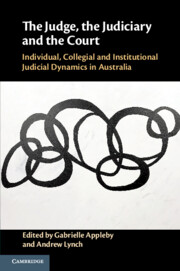 The Judge, the Judiciary and the Court
The Judge, the Judiciary and the Court from Part III - The Judiciary as a Collective
Published online by Cambridge University Press: 04 May 2021
What is encompassed by the idea of ‘style’ in judicial reasons and why might this be of value and something worth striving for in a judge’s performance of their role? Through a synthesis of judicial pronouncements on the topic from judges in common law jurisdictions, the author identifies recurring themes and typologies that are used by judges when they reflect upon what is meant by style – and the manifestations of which are to be, respectively, applauded and emulated or lamented and avoided. Lynch frames this discussion in the context of the High Court of Australia’s contemporary practice of ‘joining in’ to a draft opinion any justice who agrees with it, so that individual authorship is obscured from plain view. This practice reveals an interesting dynamic between the individual and institutional conceptions of the judicial role. 'Joining in' , and its consequences for the benefits that are to be obtained by the conscious development of individual judicial style, is contrasted with the modes of collective expression of agreement in the final courts of the United Kingdom and United States.
To save this book to your Kindle, first ensure no-reply@cambridge.org is added to your Approved Personal Document E-mail List under your Personal Document Settings on the Manage Your Content and Devices page of your Amazon account. Then enter the ‘name’ part of your Kindle email address below. Find out more about saving to your Kindle.
Note you can select to save to either the @free.kindle.com or @kindle.com variations. ‘@free.kindle.com’ emails are free but can only be saved to your device when it is connected to wi-fi. ‘@kindle.com’ emails can be delivered even when you are not connected to wi-fi, but note that service fees apply.
Find out more about the Kindle Personal Document Service.
To save content items to your account, please confirm that you agree to abide by our usage policies. If this is the first time you use this feature, you will be asked to authorise Cambridge Core to connect with your account. Find out more about saving content to Dropbox.
To save content items to your account, please confirm that you agree to abide by our usage policies. If this is the first time you use this feature, you will be asked to authorise Cambridge Core to connect with your account. Find out more about saving content to Google Drive.